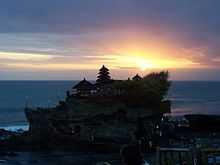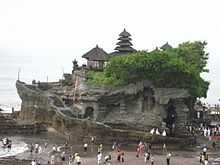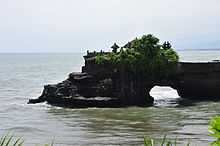Tanah Lot



Tanah Lot is a rock formation off the Indonesian island of Bali. It is home to the pilgrimage temple Pura Tanah Lot (literally "Tanah Lot temple"), a popular tourist and cultural icon for photography and general exoticism.[1]
Tanah Lot Temple
Tanah Lot means "Land [sic: in the] Sea" in the Balinese language.[2] Located in Tabanan, about 20 kilometres (12 mi) from Denpasar, the temple sits on a large offshore rock which has been shaped continuously over the years by the ocean tide.
Tanah Lot is claimed to be the work of the 16th-century Dang Hyang Nirartha. During his travels along the south coast he saw the rock-island's beautiful setting and rested there. Some fishermen saw him, and bought him gifts. Nirartha then spent the night on the little island. Later he spoke to the fishermen and told them to build a shrine on the rock, for he felt it to be a holy place to worship the Balinese sea gods.[3]
The Tanah Lot temple was built and has been a part of Balinese mythology for centuries. The temple is one of seven sea temples around the Balinese coast. Each of the sea temples was established within eyesight of the next to form a chain along the south-western coast. In addition to Balinese mythology, the temple was significantly influenced by Hinduism.
At the base of the rocky island, venomous sea snakes are believed to guard the temple from evil spirits and intruders. The temple is purportedly protected by a giant snake, which was created from Nirartha's selendang (a type of sash) when he established the island.
Restoration
In 1980, the temple's rock face was starting to crumble and the area around and inside the temple started to become dangerous.[4] The Japanese government then provided a loan to the Indonesian government of Rp 800 billion (approximately US$130 million[5]) to conserve the historic temple and other significant locations around Bali. As a result, over one third of Tanah Lot's "rock" is actually cleverly disguised artificial rock created during the Japanese-funded and supervised renovation and stabilization program.
Tourism
The area leading to Tanah Lot is highly commercialized and people are required to pay to enter the area. To reach the temple, visitors must walk through a set of Balinese market-format souvenir shops which cover each side of the path down to the sea. On the mainland clifftops, restaurants have also been provided for tourists.
See also
- Indonesian architecture
- Hindu temple architecture
Notes
- ↑ South-East Asia on a shoestring. Lonely Planet South-East Asia: On a Shoestring. Lonely Planet Edition 7. Lonely Planet Publications, 1992. ISBN 0-86442-125-7, ISBN 978-0-86442-125-8. 922. pp257
- ↑ Philip Hirsch, Carol Warren. The politics of environment in Southeast Asia: resources and resistance. Publisher Routledge, 1998 ISBN 978-0-203-03017-2. 325 pages. pp 242-244
- ↑ South-East Asia on a shoestring. Lonely Planet South-East Asia: On a Shoestring. Lonely Planet Edition 7. Lonely Planet Publications, 1992. ISBN 0-86442-125-7, ISBN 978-0-86442-125-8. 922. pp257
- ↑ Pringle, p 192-194
- ↑ 1980 exchange rate of US $1 to Rp 6000 from Gordon De Brouwer, Masahiro Kawai. Indonesian Rupiah in Exchange rate regimes in East Asia Vol 51. Publisher: Routledge, 2004. ISBN 0-415-32281-2, ISBN 978-0-415-32281-2. 466 pages
References
- Pringle, Robert (2004). Bali: Indonesia's Hindu Realm; A short history of. Short History of Asia Series. Allen & Unwin. ISBN 1-86508-863-3.
External links
| Wikimedia Commons has media related to Pura Tanah Lot. |
-
 Tanah Lot travel guide from Wikivoyage
Tanah Lot travel guide from Wikivoyage
Coordinates: 8°37′16″S 115°05′14″E / 8.62107°S 115.08716°E
| ||||||||||||||